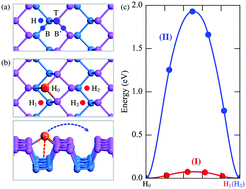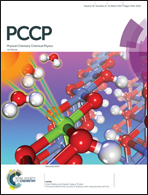From single atoms to self-assembled quantum single-atomic nanowires: noble metal atoms on black phosphorene monolayers†
Abstract
Transition metal (TM) nanostructures, such as one dimensional (1D) nanowires with/without substrates, usually possess drastically different properties from their bulk counterparts, due to their distinct stacking and electronic confinement. Correspondingly, it is of great importance to establish the dominant driving force in forming 1D single-metal-atom-wires (SMAWs). Here, with first-principles calculations, taking the black phosphorene (BP) monolayer as a prototype 2D substrate, we investigate the energetic and kinetic properties of all the 5d-TM atoms on the 2D substrate to reveal the mechanism of formation of SMAWs. In contrast to other 5d- and 4d-TMs, noble metal elements Pd and Pt are found to prefer to grow along the trough in an atom-by-atom manner, self-assembling into SMAWs with a significant magic growth behavior. This is due to distinct binding energies and diffusion barriers along the trough, i.e., zig-zag direction, as compared to other directions of the BP. The present findings are valuable in the fabrication and modulation of 1D nanostructures which can be anticipated to possess desirable functionalities for potential applications such as in nanocatalysis, nanosensors, and related areas.



 Please wait while we load your content...
Please wait while we load your content...